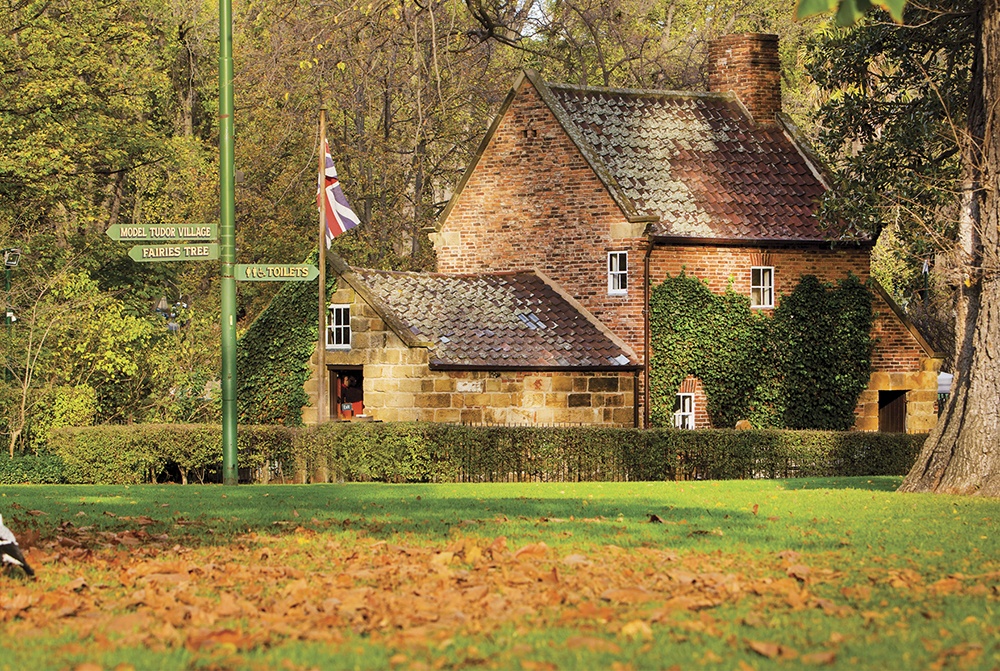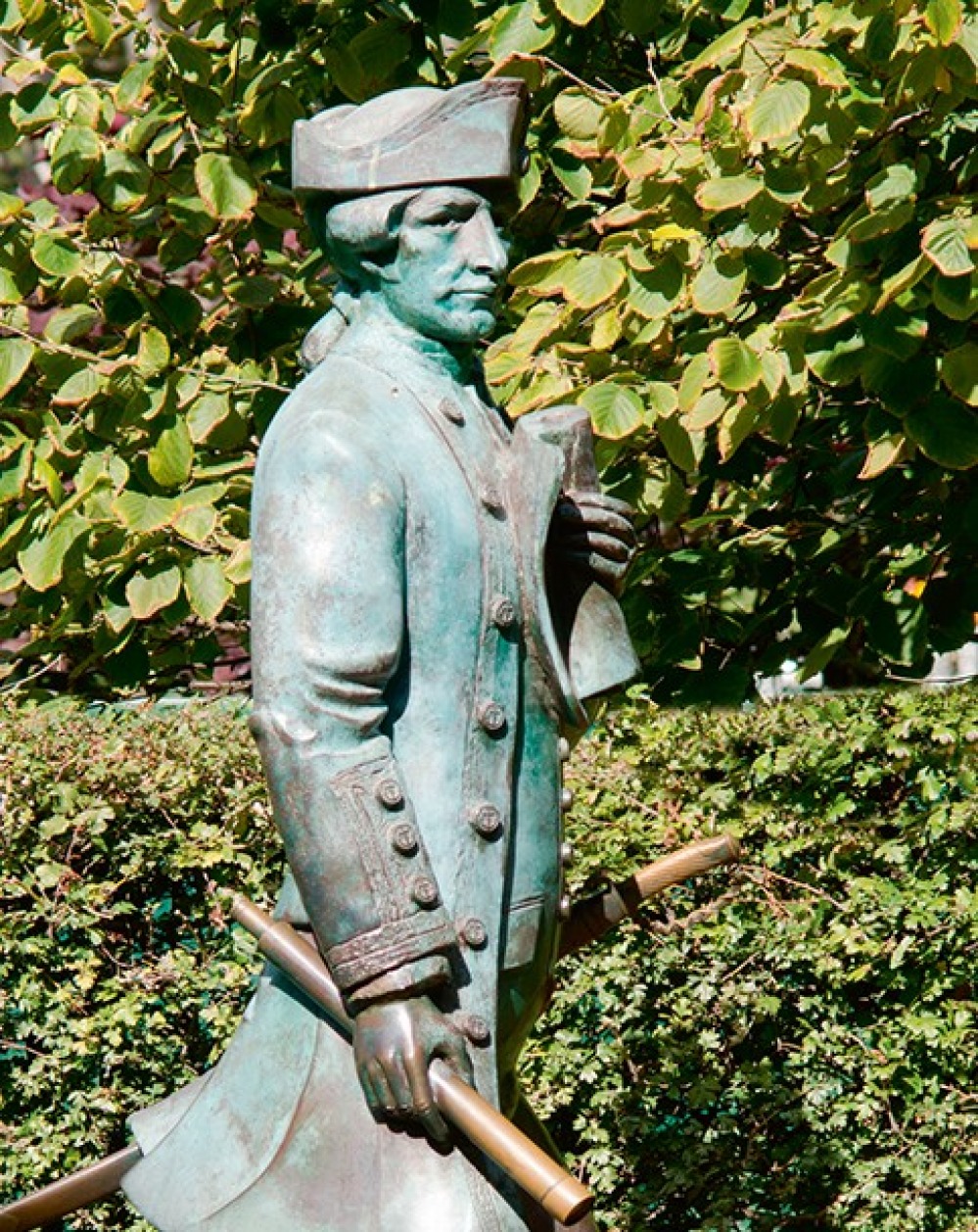Captain Cook's Cottage

Emma Newrick charts Captain James Cook’s extraordinary journey from the North East to Australia, and discovers how his father’s cottage came to rest over 10,000 miles from home in Melbourne
The story of how the cottage came to be more than 10,000 miles from where Cook’s father built it is almost as extraordinary as the tale of how a boy from a poor Yorkshire family became one of the greatest explorers and navigators in history, and it all begins in 18th century England. The year 1755 was a significant one for the whole Cook family. James Cook senior left his job as farm manager at Aireyholme Farm, where he had worked for local lord of the manor Sir Thomas Skottowe. His son, the young James Cook, joined the Royal Navy. The rest of the Cook family – James’ parents, and his two surviving sisters – moved into their new home: Cooks’ Cottage.
It is thought that the land just outside Great Ayton where the cottage was originally built may have actually been purchased for the Cooks by Skottowe as an inducement for young James to join the Navy – it was common at the time for landowners to sponsor young men to volunteer. Parish records reveal that James’ father also enjoyed a career change at this time, despite being over 60, becoming a stonemason. It was he who actually built the cottage. The initials J for James senior, G for Grace his wife, and C for Cook, along with the date, 1755, are carved into the lintel.
Though humble by our standards (and even more so given that the building we see today is roughly half the size of the original structure) the cottage was a significant step up for the Cooks – their previous home in Marton-in-Cleveland, where young James was born in 1728, was a two-roomed clay cabin. Though the famous captain himself never lived in Cooks’ Cottage, he did visit his family there between voyages – making an application to the Admiralty for three weeks’ leave between his first and second voyages, ‘having some business to transact down in Yorkshire as well as to see an aged father.’
Just as the cottage symbolised an improvement in the Cook family’s situation, young James himself was already on the path that would lead to the discovery of new lands. It’s hard for us to comprehend today just how extraordinary it was for James Cook to rise from his humble beginnings, but in 18th century England, it was rare to escape the social situation you were born into. James’ most likely path would have been to follow his father into work as a farm labourer. No one could have guessed that a poor country boy, relatively uneducated, with no experience of the sea, would one day become one of the greatest explorers in history.
However, James’ talent, resilience and ambition combined with good luck to shape his future. His first piece of fortune came when he was allowed to continue his early education, which had begun when Dame Walker taught him to read as a child in exchange for doing chores on her husband’s farm. His father’s employer, Sir Thomas Skottowe, paid for James to attend Great Ayton Village School regularly until the age of 12, when he left to join his father in working on Aireyholme Farm. It was a promising start, and more than many children got, but his story might still have ended there.
Then, at 17, James went to work for William Sanderson, a grocer and haberdasher in the nearby fishing village of Staithes – a good position for a boy from his background. However, it was surely in Staithes that he first felt the call of the sea – a call that would change the course of his life, and make history. He would have scrambled down the winding path into the fishing village and breathed in the salty air, or stood on the clifftop and watched the little fishing boats battle with the waves, and perhaps wondered about what lay beyond the horizon. Even in the shop he couldn’t escape the siren call of the ocean – all the talk would have been of the day’s catch, the boats, and tales from the lands beyond the tiny harbour.
James worked for Sanderson for 18 months, but his destiny did not lie in a grocer’s shop. His interest in the sea had not gone unnoticed, and Sanderson introduced him to his friend John Walker, a shipowner and master mariner who lived in Whitby. Walker arranged to take Cook on as an apprentice. The Walkers owned colliers or ‘Whitby-Cats’ – a type of flat bottomed wooden ship used for transporting coal and timber. The Endeavour, the ship Cook commanded on his first circumnavigation, was a similar type of ship and was also built in Whitby.
During his apprenticeship a whole new world opened up for Cook, as he studied algebra, geometry, trigonometry, navigation and astronomy. He worked on Walker’s ships between 1746 and 1755, sailing to Newcastle, Middlesbrough and London as well as more far-flung destinations like Dublin, Holland and Norway. He lived in Walker’s Whitby attic between voyages and rose in rank from apprentice to mate. His talent and dedication was obvious, and in 1755 Walker offered the 26-year-old Cook a position as Master of his own ship – an excellent opportunity. Cook, however, turned him down. The Seven Years War between England and France wouldn’t begin until 1756, but the Navy’s need for crews meant many British men were already being press-ganged into joining. Cook wanted to volunteer. Despite the fact that the now-experienced sailor would be more or less starting again at the bottom, he joined the Navy as an able-seaman on 17th June 1755.
He rose quickly through the ranks, however, and by 1759 had been promoted to Master. He was responsible for surveying the St Lawrence River: aiding the British in the siege of Quebec and helping to tip the war in Britain’s favour. The skill in charting he had demonstrated drew him to the attention of the Admiralty. When scientists and mathematicians at London’s Royal Society were working to discover how far the earth was from the sun by observing the transit of Venus across the sun’s face, they planned to place 120 groups of observers across the globe. The man put forward to captain the voyage of the Tahiti group was James Cook, aboard the Endeavour.
Cook and his crew set sail from Plymouth on 8th August 1768. On board were 94 men and provisions for 18 months at sea. The party included the wealthy young botanist Joseph Banks and his team of seven – among them botanists, artists, two servants and even two pet dogs. Banks had paid Cook the enormous sum of £10,000 to accompany him on his voyage, essentially funding the trip. It wasn’t until they were well out at sea that Cook opened sealed instructions from the Admiralty to discover that once they had observed the transit of Venus he was to attempt to find the Great Southern Continent – a mythical landmass thought to cover a large part of the southern area of the globe – and claim it for the British Empire.

The Endeavour arrived in Tahiti on 13th April 1769, and recorded the transit of Venus on 1st July. Cook and his crew left Tahiti on 13th July with a new crew member, Tupaia. A Tahitian priest, his skills as a translator and descriptions of the area from memory proved invaluable. Without him, Cook would have been forced to rely on maps given to him by the charmingly – and appropriately – named ‘speculative geographers’! The Endeavour arrived in New Zealand on 7th October 1769, where Cook spent six months charting the two islands and building relationships with the Maori. His accuracy and attention to detail was such that many of the charts he produced during his voyages were used well into the 21st century. They then sailed west until they sighted the south-eastern coast of Australia, entering Botany Bay, named for its lush plant life, on 28th April 1770. The First Fleet bearing its cargo of convicts for the British penal colony would arrive 18 years later.
Life at sea in the 18th century was dangerous. Assuming you weren’t wrecked, and managed to navigate largely uncharted waters to find safe harbour, there was still disease, cramped conditions, and the sheer length of the voyages to contend with. At six foot three inches, Cook was literally head and shoulders above his companions – but perhaps growing up in a small cabin in Yorkshire had been good training for dealing with confined spaces. Cook was also ahead of his time when it came to coping with some of the challenges of life at sea. Scurvy, caused by a lack of vitamin C, could kill more than half the crew on an 18th century voyage. Cook experimented with the link between fruit and vegetables and a lack of disease, and by providing a plant known as scurvy grass, as well as fresh produce whenever the ship encountered land, he managed not to lose a single crew member to scurvy – an astonishing feat at the time. However, the privations of life at sea inevitably took their toll. When the Endeavour sailed back into London on 12th June 1771, only 50 of the original 94 crew members remained. Damage sustained to the ship on the Great Barrier Reef had forced a stop at Batavia for repairs, and the unsanitary conditions there had led to disease.
Despite Cook’s failure to find the mythical Great Southern Continent, the voyage was judged a success, and a second trip was planned. Cook was given two more ships, the Resolution and the Adventure, and promoted to Commander in July 1771. The goal of the second voyage was to search more thoroughly for the Great Southern Continent, beginning at the Cape of Good Hope. Joseph Banks intended to join the second voyage too, but his entourage had now expanded to the point that he felt he needed more room! He made extensive alterations to the ship, including adding an additional poop deck, but the work made it dangerously top-heavy and on Cook’s recommendation the Navy removed it. Banks was so angry he refused to sail with Cook again.
On 13th July 1772 Cook’s ship the Resolution left Plymouth, accompanied by the Adventure under the command of navigator and Royal Navy officer Tobias Furneaux. In January 1773 the ships became separated in fog crossing the Antarctic Circle. Furneaux explored Tasmania’s eastern coast but was unable to discover whether it was connected to the mainland. Meanwhile, Cook arrived in New Zealand, where the two ships met up, but then became separated again. In total Cook crossed the Antarctic Circle three times, sailing further south than any explorer before him, and disproving the existence of the Great Southern Continent. Furneaux fared less well. When the Resolution arrived back in England on 29th July 1775, it was to find that some of the crew of the Adventure had been cannibalised in New Zealand. Furneaux had returned to England by the swiftest route, feeling unable to continue exploring. It was to be a grim foreshadowing of the fate that eventually awaited Cook himself.
The great explorer’s third and final voyage began in 1776: an expedition to find the North-West Passage. Cook captained the Resolution, while Charles Clerke, who had sailed with him on each of his three voyages, was in charge of the Discovery. Heading to Tasmania, New Zealand and then Tahiti, Cook discovered the Sandwich Isles, now known as Hawaii, then headed to North America and followed the Alaskan coast north. He sailed as far north as he could before the ice in the Arctic Sea forced him to turn back. He called in at Hawaii on his return in 1779, where the islanders were welcoming, but when the Resolution’s mast was damaged in a storm and the crew were forced to turn back to make repairs, the reception was not so friendly. After the Discovery’s cutter was stolen, Cook took hostages to ensure its safe return. Unfortunately, fighting broke out, and Cook was killed. He was 50 years old. The remainder of the crew headed for home, bearing the news of Cook’s death. Their search for the North West Passage was unsuccessful – like the Great Southern Continent, there was no such thing.
Cook left behind his wife Elizabeth, who had brought up their children largely alone while her husband was at sea. In 16 years of marriage, James and Elizabeth had spent only four years together. Of their six children, three died in childhood, while both the sons who followed Cook into the Navy drowned, and his youngest son Hugh died of scarlet fever while at university in Cambridge. News of Cook’s death did not reach his wife until almost a year after he had been killed, and for the rest of her life she dressed in black. Elizabeth herself outlived her husband by 56 years, dying aged 93 in the same year that Melbourne was founded, 1835.
Melbourne, of course, is where the cottage belonging to Cook’s parents is now situated, and the tale of how Cooks’ Cottage came to Australia is no less fantastical than Cook’s own story. After the Cooks left their cottage, it was occupied by different families. The final tenants, the Simpsons, left the cottage in 1929, and in 1932 the local council decided to widen the road that ran alongside. They knocked down half the existing cottage to do so – the cottage you can see today is therefore only half the size it would have been in Cook’s day. By 1933, house prices were falling in the Great Depression. The cottage had been empty for four years, and the owners, the Dixons, decided to put it up for auction. The sale garnered interest worldwide, and the family were inundated with requests for pieces of stone or wood as souvenirs. However, they were adamant that they wanted the cottage to remain in one piece, in England.
Meanwhile, an article appeared in Melbourne newspaper The Herald, and an Australian historian who had actually visited the cottage a few years previously alerted the Council for Melbourne’s Centenary, who were looking for a way to mark the historic occasion of the city’s founding. Sir Russell Grimwade, philanthropist and a member of the Council, decided to buy the cottage as a gift for the state of Victoria and as a focus for the centenary celebrations in 1934, and move it to Melbourne. It’s probable that Grimwade’s generous bid of £800, in comparison to the highest local bid of £300, went some way towards persuading the Dixons to allow the cottage to leave the country.
The cottage was painstakingly dismantled, supervised by York-based architects Brierley, Rutherford and Syme. Each piece was carefully numbered, the carved lintel was encased in concrete, and even the plaster and mortar were ground down and packed into barrels. Then the whole cottage was transported to Hull, in 253 crates and 40 barrels, to begin the journey to Australia aboard the Port Dunedin. The total cost of dismantling, moving and rebuilding the cottage was more than £1,700, equating to just under half a million pounds today. Grimwade commissioned a memorial obelisk to stand in its place, a gift to the people of Yorkshire. Made of granite quarried at Port Hicks – the first place Cook sighted Australian shores – the Great Ayton monument mirrors the obelisk that stands at Port Hicks.
On its arrival in Melbourne, there was some discussion about where to place the cottage. Suggestions included on the foreshore at St Kilda, and in front of the State Library of Victoria (there was even a group keen to place the cottage inside the State Library). In the end, the more rural setting of Fitzroy Gardens, where Australian native trees and plants grow beside European flora, was chosen.
The cottage was rebuilt, following the plans so exactly that a wall that had begun to lean was re-assembled to incorporate the fault, much to the builders’ annoyance. The ivy growing up the wall was grown from a cutting of the original plant, also brought from Yorkshire. The cottage is even located on Goats Lane – as it was in Yorkshire. Inside, the oldest building in Australia reflects Cook’s humble beginnings. What is left of the original building – roughly half – contains two main rooms. The kitchen is the main focus and would have been where the Cook family spent most of their time. Upstairs, the main bedroom is accessed via a winding staircase – James would certainly have needed to mind his head. Even the cottage garden is a recreation of how it might have looked in Cook’s day - with a few notable exceptions. The scent of lavender mingles with rosemary, but the scurvy grass wouldn’t have been found in a typical Yorkshire country garden. Here, it’s a nod to James’ innovative approach to provisions aboard ship.
A bronze statue of the great Captain himself, almost life size, presides over the garden, gazing serenely into the distance. He holds the tools of his trade – a telescope and chart – while a Union Jack flaps in the breeze above the cottage roof. It’s all a long way from the place where he was born, but for a man who dedicated his life to discovering new worlds, perhaps this little corner of Yorkshire in a foreign land is close enough to home.




